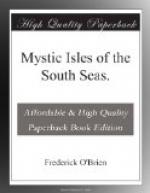A white flower over the ear seemed a favorite adornment, some wearing it on one side and some on the other. What struck one immediately was the erect carriage of the women. They were tall and as straight as sunflower-stalks, walking with a swimming gait. They were graceful even when old. Those dark women and men seemed to fit in perfectly with the marvelous background of the cocoas, the bananas and the brilliant foliage. The whites appeared sickly, uncouth, beside the natives, and the white women, especially, faded and artificial.
The Noa-Noa was warped to the wharf, and I was within a few feet now of the welcoming crowd and could discern every detail.
Those young women were well called les belles Tahitiennes. Their skins were like pale-brown satin, but exceeding all their other charms were their lustrous eyes. They were very large, liquid, melting, and indescribably feminine—feminine in a way lost to Occidental women save only the Andalusians and the Neapolitans. They were framed in the longest, blackest, curly lashes, the lashes of dark Caucasian children. They were the eyes of children of the sun, eyes that had stirred disciplined seamen to desertion, eyes that had burned ships, and created the mystery of the Bounty, eyes of enchantresses of the days of Helen.
“Prenez-garde vous!” said Madame Aubert, the invalid, in my ear.
Mixed now with the perfumes of the flowers was the odor of cocoanuts, coming from the piles of copra on the dock, a sweetish, oily smell, rich, powerful, and never in foreign lands to be inhaled without its bringing vividly before one scenes of the tropics.
The gangway was let down. I was, after years of anticipation, in Tahiti.
Chapter III
Description of Tahiti—A volcanic rock and coral reef—Beauty of the Scenery—Papeete the center of the South Seas—Appearance of the Tahitians.
Tahiti was a molten rock, fused in a subterranean furnace, and cast in some frightful throe of the cooling sphere, high up above the surface of the sea, the seething mass forming into mountains and valleys, the valleys hemmed in except at their mouths by lofty barriers that stretch from thundering central ridges to the slanting shelf of alluvial soil which extends to the sand of the beach. It is a mass of volcanic matter to which the air, the rain, and the passage of a million years have given an all-covering verdure except upon the loftiest peaks, have cut into strangely shaped cliffs, sloping hills, spacious vales, and shadowy glens and dingles, and have poured down the rich detritus and humus to cover the coral beaches and afford sustenance for man and beast. About the island countless trillions of tiny animals have reared the shimmering reef which bears the brunt of the breaking seas, and spares their impact upon the precious land. These minute beings in the unfathomable scheme of the Will had worked and perished for unguessed ages to leave behind this monument of their existence, their charnel-house. Man had often told himself that a god had inspired them thus to build havens for his vessels and abodes of marine life where man might kill lesser beings for his food and sport.




